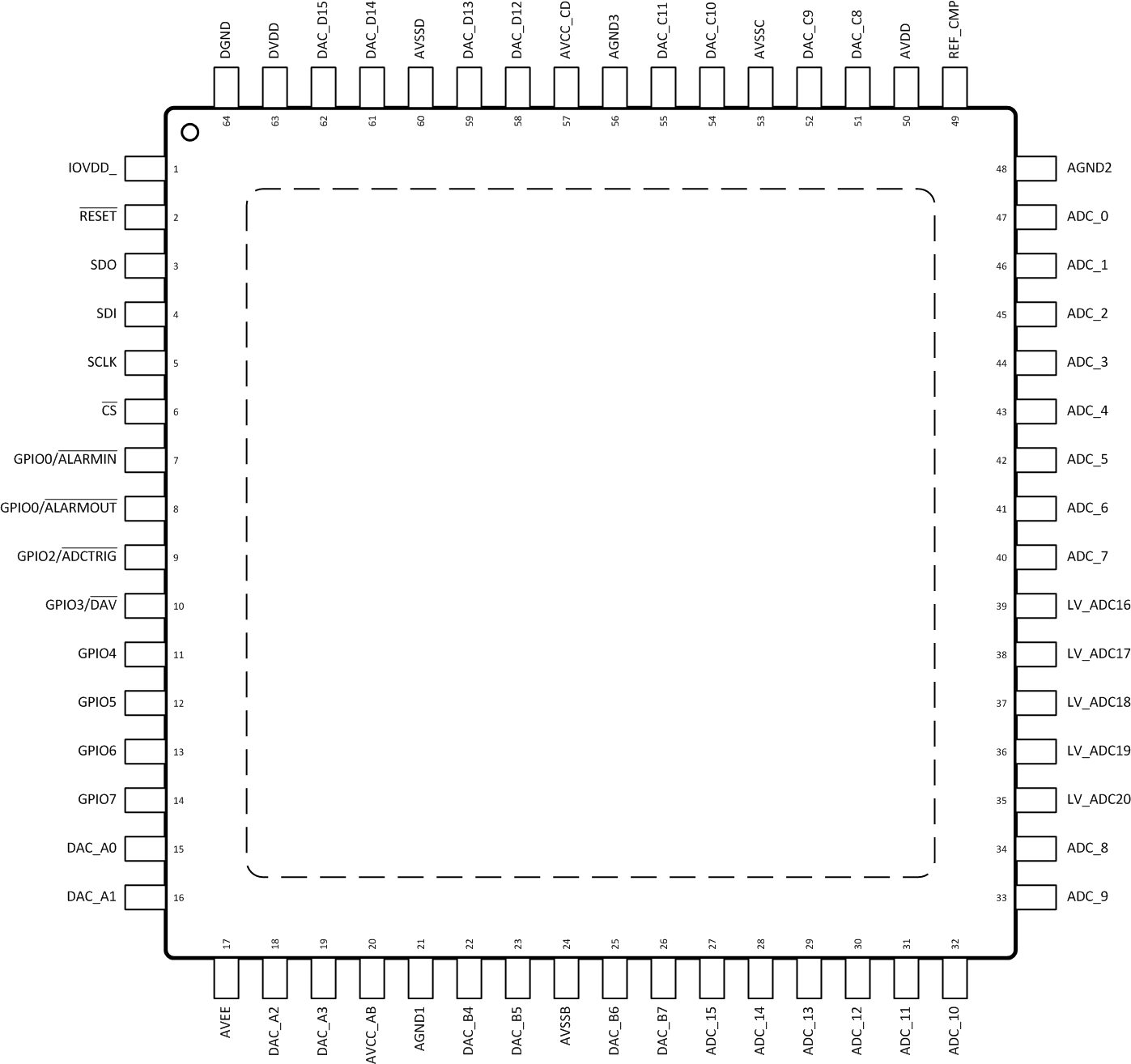ZHCSDC6D November 2014 – February 2018 AMC7836
PRODUCTION DATA.
- 1 特性
- 2 应用
- 3 说明
- 4 修订历史记录
- 5 Pin Configuration and Functions
-
6 Specifications
- 6.1 Absolute Maximum Ratings
- 6.2 ESD Ratings
- 6.3 Recommended Operating Conditions
- 6.4 Thermal Information
- 6.5 Electrical Characteristics: DAC
- 6.6 Electrical Characteristics: ADC and Temperature Sensor
- 6.7 Electrical Characteristics: General
- 6.8 Timing Requirements
- 6.9 Typical Characteristics: DAC
- 6.10 Typical Characteristics: ADC
- 6.11 Typical Characteristics: Reference
- 6.12 Typical Characteristics: Temperature Sensor
-
7 Detailed Description
- 7.1 Overview
- 7.2 Functional Block Diagram
- 7.3 Feature Description
- 7.4 Device Functional Modes
- 7.5 Programming
- 7.6
Register Maps
- 7.6.1 Interface Configuration: Address 0x00 – 0x02
- 7.6.2
Device Identification: Address 0x03 – 0x0D
- 7.6.2.1 Chip Type Register (address = 0x03) [reset = 0x08]
- 7.6.2.2 Chip ID Low Byte Register (address = 0x04) [reset = 0x36]
- 7.6.2.3 Chip ID High Byte Register (address = 0x05) [reset = 0x0C]
- 7.6.2.4 Version ID Register (address = 0x06) [reset = 0x00]
- 7.6.2.5 Manufacturer ID Low Byte Register (address = 0x0C) [reset = 0x51]
- 7.6.2.6 Manufacturer ID High Byte Register (address = 0x0D) [reset = 0x04]
- 7.6.3 Register Update (Buffered Registers): Address 0x0F
- 7.6.4
General Device Configuration: Address 0x10 through 0x17
- 7.6.4.1 ADC Configuration Register (address = 0x10) [reset = 0x00]
- 7.6.4.2 False Alarm Configuration Register (address = 0x11) [reset = 0x70]
- 7.6.4.3 GPIO Configuration Register (address = 0x12) [reset = 0x00]
- 7.6.4.4 ADC MUX Configuration 0 Register (address = 0x13) [reset = 0x00]
- 7.6.4.5 ADC MUX Configuration 1 Register (address = 0x14) [reset = 0x00]
- 7.6.4.6 ADC MUX Configuration 2 Register (address = 0x15) [reset = 0x00]
- 7.6.4.7 DAC Clear Enable 0 Register (address = 0x18) [reset = 0x00]
- 7.6.4.8 DAC Clear Enable 1 Register (address = 0x19) [reset = 0x00]
- 7.6.5 DAC Clear and ALARMOUT Source Select: Address 0x1A through 0x1D
- 7.6.6 DAC Range: Address 0x1E
- 7.6.7
ADC and Temperature Data: Address 0x20 through 0x4B
- 7.6.7.1 ADCn-Data (Low Byte) Register (address = 0x20 through 0x49) [reset = 0x00]
- 7.6.7.2 ADCn-Data (High Byte) Register (address = 0x20 through 0x49) [reset = 0x00]
- 7.6.7.3 Temperature Data (Low Byte) Register (address = 0x4A) [reset = 0x00]
- 7.6.7.4 Temperature Data (High Byte) Register (address = 0x4B) [reset = 0x00]
- 7.6.8 DAC Data: Address 0x50 through 0x6F
- 7.6.9 Status Registers: Address 0x70 through 0x72
- 7.6.10 GPIO: Address 0x7A
- 7.6.11
Out-Of-Range ADC Thresholds: Address 0x80 through 0x93
- 7.6.11.1 ADCn-Upper-Thresh (Low Byte) Register (address = 0x80 through 0x93) [reset = 0xFF]
- 7.6.11.2 ADCn-Upper-Thresh (High Byte) Register (address = 0x80 through 0x93) [reset = 0x0F]
- 7.6.11.3 ADCn-Lower-Thresh (Low Byte) Register (address = 0x80 through 0x93) [reset = 0x00]
- 7.6.11.4 ADCn-Lower-Thresh (High Byte) Register (address = 0x80 through 0x93) [reset = 0x00]
- 7.6.11.5 LT-Upper-Thresh (Low Byte) Register (address = 0x94) [reset = 0xFF]
- 7.6.11.6 LT-Upper-Thresh (High Byte) Register (address = 0x95) [reset = 0x07]
- 7.6.11.7 LT-Lower-Thresh (Low Byte) Register (address = 0x96) [reset = 0x00]
- 7.6.11.8 LT-Lower-Thresh (High Byte) Register (address = 0x97) [reset = 0x08]
- 7.6.12 Alarm Hysteresis Configuration: Address 0xA0 and 0xA5
- 7.6.13
Clear and Power-Down Registers: Address 0xB0 through 0XB4
- 7.6.13.1 DAC Clear 0 Register (address = 0xB0) [reset = 0x00]
- 7.6.13.2 DAC Clear 1 Register (address = 0xB1) [reset = 0x00]
- 7.6.13.3 Power-Down 0 Register (address = 0xB2) [reset = 0x00]
- 7.6.13.4 Power-Down 1 Register (address = 0xB3) [reset = 0x00]
- 7.6.13.5 Power-Down 2 Register (address = 0xB4) [reset = 0x00]
- 7.6.14 ADC Trigger: Address 0xC0
- 8 Application and Implementation
- 9 Power Supply Recommendations
- 10Layout
- 11器件和文档支持
- 12机械、封装和可订购信息
5 Pin Configuration and Functions
PAP Package
64-Pin HTQFP With Exposed Thermal Pad
Top View
